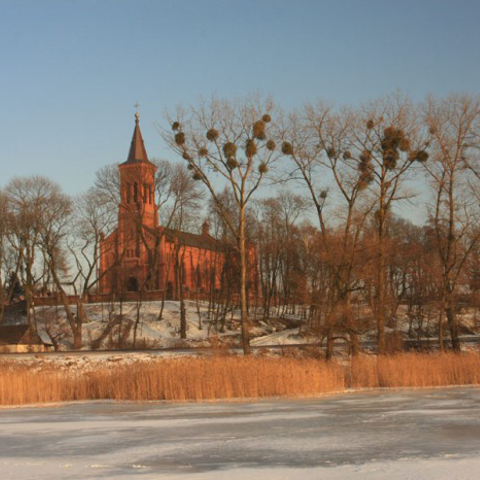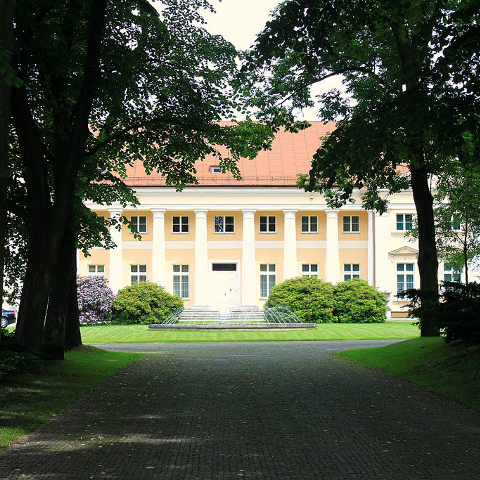Composers / Fryderyk Chopin / Places catalog
Kikół
Kikół is first mentioned as Kychol in documents from 1236. The place referred to was probably an enclosed settlement on a 10 m rise on which an early twentieth-century church now stands. Kikół was destroyed during a Prussian raid in the middle of the thirteenth century. In 1391, the owner of the area was Sir John of Kikół. Four years later, he sold it to the Teutonic Knights, on whose side he fought in the Polish-Lithuanian-Teutonic War (1409–1411).
The Zboiński family, especially Ignacy Antoni Zboiński, the Voivode of Płock, contributed greatly to the development of the area. Zboiński came into possession of part of Kikół following the death of his father and obtained the consent of King Augustus III to build a town there in 1745. In 1790, he had a neo-classical palace built there, with a garden and a greenhouse. The palace was probably designed by Stanisław Zawadzki and is considered to be one of the most beautiful buildings in the Dobrzyń area. In 1796, the property passed to his son, Franciszek Ksawery. Franciszek financed the building of a brick church, where he and his wife (Joanna Zboińska, née Grabieńska) were buried. Unfortunately, the church is no longer there. The Neo-Gothic Church of St Wojciech that stands there now was built in 1904–1909.
From 1818, the estate was the property of Karol Zboiński, whom Chopin visited in the summer of 1827. The composer had arrived from Rościszewo and was on his way to Gdańsk. Unfortunately, the palace has no details about his stay there. Chopin might have visited previously, as he spent his 1824 and 1825 summer holidays in Szafarnia, just 30 km to the north.
Over time, other families came to own the estate: the Piwnicki family in 1855 and the Nałęcz family in 1902. Kikół had its town privileges revoked in 1867 for its participation in the January Uprising (1863–1864). In 1937, the indebted property was auctioned. Part of it became the property of the Chełmica sugar factory (the palace was set aside for a school). After the Second World War, the State Treasury assumed ownership of the ruined building, and it was restored and converted into a recreation centre. The palace and its grounds are now private property.
It should be mentioned here that the Zboiński family had an indirect but significant impact on the fate of the Chopin family. Franciszek Ksawery Zboiński, the last Płock castellan and senator, was a descendant of Franciszek Zboiński, the crown court gamekeeper. In 1800, Franciszek Ksawery purchased a property in Izbica Kujawska from the Treasury. Justyna Krzyżanowska, the composer’s mother, had been living there all her life when she moved to Żelazowa Wola with her employers, the Skarbek family. It was there that she met Mikołaj Chopin. In 1827, Chopin visited Karol Zboiński, the son of the Płock castellan and owner of the Kikól property, on his way to Pomerania. The castellan Franciszek Ksawery is often confused (on account of having the same forename) with the Count Zboiński who looked after Chopin in Kowalewo and who probably accompanied him to Pomerania. The Zboińskis who owned Kikół descended from the court gamekeeper, Franciszek, whereas the Zboińskis from Kozłowo (and Kowalewo) descended from his brother, Jakub.
The palace in Kikół, with its characteristic row of six columns in a deep portico, is a type of country residence seldom encountered. Several trompe-l’œil paintings with architectural themes dating from the late eighteenth and early nineteenth centuries have survived and are hanging on the walls of the Knights Hall. The palace stands on an embankment by a pond. In the early twentieth century, the grounds were rearranged by Stefan Celichowski.
In St Wojciech’s church, there are epitaphs to the Zboińskis, including Ignacy Antoni (d. 1796), Franciszek Ksawery (d. 1818) and Karol (d. 1850). They were brought there from the previous church. The mid eighteenth-century rococo baptismal font and the 1817 crucifixion painting are especially valuable decorative items.
-

Bird’s-eye view of Kikół. Phot. PWR.
-
.jpg)
Bird’s-eye view of Kikół. Phot. PWR.
-

St Wojciech Church in Kikół. Phot. PWR.
-

Zboiński Palace in Kikół. Phot. Andrzej Maćkiewicz.